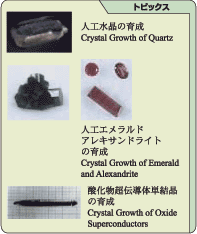Overview
 In 1962, the Institute of Inorganic Synthesis (IIS), which was the predecessor of this research center, was established by an ordinance of the Ministry of Education, as a research institute affiliated to the Faculty of Engineering. It consisted of only one department – the “Division of Mineral Synthesis” – involved in the artificial synthesis of natural minerals and precious stones. Research on crystal growth of quartz deserves special mention, as the institute received various awards for this research, including the Director-General of Science and Technology Award. Soon after, the Division of Inorganic Synthesis and the Division of Surface Science were added in 1964 and 1973, respectively, leading to the establishment of departments that dealt with the exploration and synthesis of novel inorganic compounds and those that dealt with single crystal growth and surface analysis of single crystalline materials. Meanwhile, as a unique research facility established in the Yamanashi prefecture, which is a hub for polishing and processing precious stones and producing quartz oscillators in Japan, this research facility contributed to the development of the prefecture owing to its close interaction with the local industries. Moreover, it was simultaneously contributing to the development of inorganic materials science through research, aiming toward a world that responded to the remarkable progress in the field of inorganic materials marked as artificial minerals. Through this research process, success was achieved for the first time in the growth of high-purity superconducting single oxide crystals on a large scale, and this resulted in the establishment of a newly constructed Division of Synthesis of Superconducting Materials in 1992.
In 1962, the Institute of Inorganic Synthesis (IIS), which was the predecessor of this research center, was established by an ordinance of the Ministry of Education, as a research institute affiliated to the Faculty of Engineering. It consisted of only one department – the “Division of Mineral Synthesis” – involved in the artificial synthesis of natural minerals and precious stones. Research on crystal growth of quartz deserves special mention, as the institute received various awards for this research, including the Director-General of Science and Technology Award. Soon after, the Division of Inorganic Synthesis and the Division of Surface Science were added in 1964 and 1973, respectively, leading to the establishment of departments that dealt with the exploration and synthesis of novel inorganic compounds and those that dealt with single crystal growth and surface analysis of single crystalline materials. Meanwhile, as a unique research facility established in the Yamanashi prefecture, which is a hub for polishing and processing precious stones and producing quartz oscillators in Japan, this research facility contributed to the development of the prefecture owing to its close interaction with the local industries. Moreover, it was simultaneously contributing to the development of inorganic materials science through research, aiming toward a world that responded to the remarkable progress in the field of inorganic materials marked as artificial minerals. Through this research process, success was achieved for the first time in the growth of high-purity superconducting single oxide crystals on a large scale, and this resulted in the establishment of a newly constructed Division of Synthesis of Superconducting Materials in 1992.
In April 2002, that is, 40 years after the establishment of the IIS by the ordinance from MEXT, the center was renamed “Center for Crystal Science and Technology” and reorganized into two enlarged divisions : “Research Division of Crystal Bond Engineering” and “Research Division Crystal Structure Engineering.” This was in response to severe changes in the education system and society in the recent years and for achieving dynamic development in new areas of crystalline materials required in the 21st century. While applying the knowledge accumulated and technology developed until now, this research center is contributing to the development of science and technology as well as the society of our country, by striving for breaking through the occluded state of materials research, in response to the demands of the present age.
Since April 2008, this research center changed its position from its affiliation to the faculty of engineering to a research facility affiliated to the Interdisciplinary Graduate School of Medicine and Engineering. Since October 2014, this research center has been affiliated to the Graduate Faculty of Interdisciplinary Research. By strengthening its graduate school of master and doctoral courses further, it is proactively accepting graduate students from domestic and oversea.
Chronicle
| 1962 | The Institute of Inorganic Synthesis was established as an organization with only one division, that is, the Division of Mineral Synthesis. |
| 1964 | The Division of Inorganic Synthesis was established. |
| 1973 | The Division of Surface Science was established. |
| 1992 | The Division of Synthesis of Superconducting Materials was established. |
| 2002 | The Institute was reorganized into the Center for Crystal Science and Technology (CCST). |
| 2008 | CCST was affiliated to the Interdisciplinary Graduate School of Medicine and Engineering. |
| 2014 | CCST was affiliated to the Graduate Faculty of Interdisciplinary Research. |




















